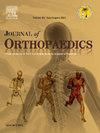Randomized trials evaluating volar locking plates against casting of distal radius fractures are statistically fragile: A systematic review
IF 1.5
Q3 ORTHOPEDICS
引用次数: 0
Abstract
Introduction
Despite randomized controlled trials (RCTs) largely supporting volar locking plates (VLPs) for the management of distal radius fractures (DRFs), surgeons often opt for non-invasive interventions such as casting. This study used the fragility index (FI), reverse fragility index (rFI), and fragility quotient (FQ) to assess the statistical robustness of RCTs assessing the efficacy of VLP in DRF management.
Methods
PubMed, Embase, and MEDLINE were queried for RCTs evaluating VLP versus casting for DRFs published from January 1st, 2000–June 30, 2024. FI and rFI were quantified for all dichotomous outcomes, and represent the number of event reversals required to alter statistical significance or non-significance, respectively. The FQ was then determined by dividing the FI or rFI by the sample size. A subanalysis was performed for outcomes pertaining to patient satisfaction, healing/function, and adverse events.
Results
A total of 699 RCTs were identified in the initial literature search. 13 RCTs were eventually included in the final analysis, yielding 36 dichotomous outcomes. The median FI across these outcomes was 3 (IQR 3–5) and the median FQ was 0.037 (IQR 0.014–0.067). Among the 15 significant outcomes, the median FI was 2 (IQR 2–4) and the median FQ was 0.029 (IQR 0.013–0.055). The remaining 21 non-significant outcomes yielded a median rFI of 4 (IQR 2–5) and a median FQ of 0.042 (IQR 0.021–0.091). The most statistically fragile outcome category was patient satisfaction, with a median FI of 2 (IQR 2–3.5) and median FQ of 0.016 (IQR 0.013–0.030). Among 21 of the included outcomes (58.3 %), the number of patients lost to follow up exceeded the respective FI or rFI.
Conclusion
A statistical fragility analysis of VLP versus casting for DRFs demonstrated fragile outcomes, reporting a median FQ of 0.037, or 3.7 %. Statistically significant outcomes and patient satisfaction results were particularly fragile, and large losses to follow up were found to be an important contributor to RCT fragility. Although VLP is largely recommended by level I evidence, its superiority may not be as ubiquitous as argued by contemporary literature.
评估掌侧锁定钢板对桡骨远端骨折铸造的随机试验在统计学上是脆弱的:一项系统综述
尽管随机对照试验(rct)在很大程度上支持掌侧锁定钢板(VLPs)治疗桡骨远端骨折(drf),但外科医生通常选择非侵入性干预,如铸造。本研究采用脆弱性指数(FI)、反向脆弱性指数(rFI)和脆弱性商(FQ)来评估评估VLP在DRF管理中的有效性的随机对照试验的统计稳健性。方法查询spubmed、Embase和MEDLINE,检索2000年1月1日至2024年6月30日发表的drf中评价VLP与铸造的rct。FI和rFI对所有二分类结果进行量化,分别表示改变统计显著性或不显著性所需的事件逆转次数。然后通过将FI或rFI除以样本量来确定FQ。对患者满意度、愈合/功能和不良事件相关的结果进行了亚分析。结果初步文献检索共纳入699项rct。13项随机对照试验最终纳入最终分析,产生36个二分类结果。这些结果的中位FI为3 (IQR 3 - 5),中位FQ为0.037 (IQR 0.014-0.067)。15个显著结局中,FI中位数为2 (IQR 2 - 4), FQ中位数为0.029 (IQR 0.013-0.055)。其余21个无显著性结局的中位rFI为4 (IQR 2-5),中位FQ为0.042 (IQR 0.021-0.091)。统计上最脆弱的结局类别是患者满意度,中位FI为2 (IQR 2 - 3.5),中位FQ为0.016 (IQR 0.013-0.030)。在21个纳入的结局中(58.3%),失去随访的患者数量超过了各自的FI或rFI。统计脆弱性分析表明,VLP与铸造DRFs的结果是脆弱的,报告的中位FQ为0.037,或3.7%。具有统计学意义的结果和患者满意度结果特别脆弱,随访的大量损失被发现是RCT脆弱性的重要因素。虽然VLP在很大程度上被推荐为一级证据,但它的优越性可能并不像当代文献所争论的那样普遍存在。
本文章由计算机程序翻译,如有差异,请以英文原文为准。
求助全文
约1分钟内获得全文
求助全文
来源期刊

Journal of orthopaedics
ORTHOPEDICS-
CiteScore
3.50
自引率
6.70%
发文量
202
审稿时长
56 days
期刊介绍:
Journal of Orthopaedics aims to be a leading journal in orthopaedics and contribute towards the improvement of quality of orthopedic health care. The journal publishes original research work and review articles related to different aspects of orthopaedics including Arthroplasty, Arthroscopy, Sports Medicine, Trauma, Spine and Spinal deformities, Pediatric orthopaedics, limb reconstruction procedures, hand surgery, and orthopaedic oncology. It also publishes articles on continuing education, health-related information, case reports and letters to the editor. It is requested to note that the journal has an international readership and all submissions should be aimed at specifying something about the setting in which the work was conducted. Authors must also provide any specific reasons for the research and also provide an elaborate description of the results.
 求助内容:
求助内容: 应助结果提醒方式:
应助结果提醒方式:


